PVM-2530 popping sound notice arching/lighting/spark in rear
-
patastinky
- Posts: 24
- Joined: Mon Nov 10, 2014 7:23 pm
PVM-2530 popping sound notice arching/lighting/spark in rear
Hi guys
So I finally was able to pick up a PVM monitor. For extremely cheap on craigslist. However I'm having a big problem with it I picked it up as a repair thinking that it was only a sound issue. However when I opened up the back and turn the monitor on I noticed the spark. The monitor is not displaying a picture. Is this something I can fix I am pretty handy and know how to solder capacitors. Just not sure where to begin with this.
I took a video of the issue. I hope someone can help. The plan is to RGB all my retro gaming consoles and hook them up to this monitor.
http://youtu.be/1FSmrZrAdWA
So I finally was able to pick up a PVM monitor. For extremely cheap on craigslist. However I'm having a big problem with it I picked it up as a repair thinking that it was only a sound issue. However when I opened up the back and turn the monitor on I noticed the spark. The monitor is not displaying a picture. Is this something I can fix I am pretty handy and know how to solder capacitors. Just not sure where to begin with this.
I took a video of the issue. I hope someone can help. The plan is to RGB all my retro gaming consoles and hook them up to this monitor.
http://youtu.be/1FSmrZrAdWA
patastinky
Re: PVM-2530 popping sound notice arching/lighting/spark in
Sorry, no idea what could be causing that, I had the same monitor, hope you can save it.patastinky wrote:Hi guys
So I finally was able to pick up a PVM monitor. For extremely cheap on craigslist. However I'm having a big problem with it I picked it up as a repair thinking that it was only a sound issue. However when I opened up the back and turn the monitor on I noticed the spark. The monitor is not displaying a picture. Is this something I can fix I am pretty handy and know how to solder capacitors. Just not sure where to begin with this.
I took a video of the issue. I hope someone can help. The plan is to RGB all my retro gaming consoles and hook them up to this monitor.
http://youtu.be/1FSmrZrAdWA
Nyd
-
patastinky
- Posts: 24
- Joined: Mon Nov 10, 2014 7:23 pm
Re: PVM-2530 popping sound notice arching/lighting/spark in
I hope so too. Not sure where else to ask for help. First time I did a Google search for PVM-2530 I came across this site. Hopefully someone can help.nyder wrote:Sorry, no idea what could be causing that, I had the same monitor, hope you can save it.patastinky wrote:Hi guys
So I finally was able to pick up a PVM monitor. For extremely cheap on craigslist. However I'm having a big problem with it I picked it up as a repair thinking that it was only a sound issue. However when I opened up the back and turn the monitor on I noticed the spark. The monitor is not displaying a picture. Is this something I can fix I am pretty handy and know how to solder capacitors. Just not sure where to begin with this.
I took a video of the issue. I hope someone can help. The plan is to RGB all my retro gaming consoles and hook them up to this monitor.
http://youtu.be/1FSmrZrAdWA
Nyd
patastinky
-
patastinky
- Posts: 24
- Joined: Mon Nov 10, 2014 7:23 pm
Re: PVM-2530 popping sound notice arching/lighting/spark in
Update: So i've been all over the internet trying to figure out what to do. I came across a few inspiring threads that have really sparked a fire in me and now i want to see this thing through. At any rate, it looks like the red box is called a "fly back." So i'm going to continue my search to see if these things are fixable or if i can find one that is working maybe I can swap it out. I understand that before working with the CRT i need to discharge the tube. Therefore i'll be heading to HOMEDEPOT tomorrow to pick up some alligator clips in order to discharge the tube (as seen on YouTube) before working on it.
patastinky
Re: PVM-2530 popping sound notice arching/lighting/spark in
I have seen some companies that provide flyback transformers for CRTs, though I'm not sure how easy it is to replace them inside a monitor. They appear to be soldered on most units.
-
patastinky
- Posts: 24
- Joined: Mon Nov 10, 2014 7:23 pm
Re: PVM-2530 popping sound notice arching/lighting/spark in
Right. I came across that in another thread. Someone mentioned that the fly back is soldered. It's no problem I know how to solder and desolder very well. Just need to find the parts.Ed Oscuro wrote:I have seen some companies that provide flyback transformers for CRTs, though I'm not sure how easy it is to replace them inside a monitor. They appear to be soldered on most units.
patastinky
Re: PVM-2530 popping sound notice arching/lighting/spark in
Find the part number off it and do a search, that should work.
-
patastinky
- Posts: 24
- Joined: Mon Nov 10, 2014 7:23 pm
Re: PVM-2530 popping sound notice arching/lighting/spark in
So i've dug up more information via http://www.repairfaq.org/REPAIR/F_monfa ... ONFAQD_012
It looks like the BIG RED BOX thing is a large capacitor as per the website. It says the P/N 910-0058, which i'll confirm later tonight if that's what it says on mine. I've copy & pasted what the site says for those that are interested and do not want to click on the link above.
It looks like the BIG RED BOX thing is a large capacitor as per the website. It says the P/N 910-0058, which i'll confirm later tonight if that's what it says on mine. I've copy & pasted what the site says for those that are interested and do not want to click on the link above.
Spoiler
12.28) Apple/Sony monitor dies after variable length of time
The following discussion relates to failures of the X-ray protection tap
on a Sony part affectionately known as the 'big red cap' or the HSTAT
block in some Sony manufactured monitors.
"This is a (Apple) Sony 13" monitor, 4 years old. After being turned on
for 30 minutes, the display goes completely blank and the front LED goes
off. If the power is shut off for 10 minutes or so, it will come back on
for another 15 minutes or so, then go blank again, etc. The +120v and
+65v from the power module is still present when it blanks out, but no
other voltages (+12, +960, etc) are present on the main circuit board.
I've been told it might be the HV capacitor is bad; would like to hear a
2nd or 3rd opinion before buying a new capacitor."
That is the same diagnosis a friend of mine got for her monitor with that
identical problem. Replacing the capacitor did fix the problem.
That 'big red capacitor' is a Sony part which includes some kind of low
voltage sense connection as well. It is used to shut the monitor or TV
down should the HV increase resulting in increased risk of X-ray generation.
Unfortunately, the resistors inside often go bad causing the unit to shut
off erroneously. The guy at the place where she got it repaired said that
the capacitor is one of the most common problems with those monitors. $70
for the part + $50 for labor, ouch!
These used to be only available from Sony. Why can't Sony design monitors
like everyone else? Sure, I know, theirs are better (well, except for the
unsightly stabilizing wires on Trinitrons!). Now, however, less expensive
replacements can be had at places like Computer Component Source.
For testing, it may be possible to disconnect the sense output. With shutdown
disabled, the monitor should continue to run BUT WITH NO X-RAY PROTECTION.
Therefore, this should only be used for testing - a replacement will be
required.
Note: On some models, the sense wires need to be connected during startup
or else it will never come on.
CAUTION: On some models (like the Sony CPD1302), the sense signal may be used
for actual HV regulation. Thus, if the sense wire is disconnected, (or the
divider inside the Hstat block fails open) there is no feedback and it is
possible for the high voltage (and probably B+) to increase until the HOT
(and possible other components) blow.
(From: Duke Beattie (beattie@wsu.edu)).
The low voltage connection of the 'big red cap' is part of the "X-ray
protection" circuit. If the high voltage to the crt goes to high it is
supposed to shut down the whole thing. Unfortunately the sensor inside
goes bad and puts out the wrong voltage and that shuts down the world.
The part is available at "Computer Component Source" for about $30, it is
a "M041" (Sony/Apple part number" These things go out with great regularity.
So if your Apple monitor shuts down this is probably the culprit.
(From: A.R. Duell (ard12@eng.cam.ac.uk)).
On some of the older Trinitrons (certainly on the 13" Trinitron monitor
I have), the HSTAT pot is connected as a potential divider on the EHT
supply. The slider of the pot is connected to the static convergence
electrode, but a tap on the lower end of the pot goes to the protection
circuit. Something like this:
Static Conv Electrode
o
|
V
EHT---------/\/\/\-------\/\/\---+---\/\/\-----+
| |
o _|_
Protection ///
If the EHT rises too high, then the voltage at the protection point also
rises, and a shutdown signal is sent to the scan processor.
All those resistors are encapsulated in the HSTAT block which has an EHT
input from the flyback, a Coaxial EHT output (EHT and Hstat electrode) to the
CRT, an earth wire, and a 2 core cable (earth and Protection) that goes
to the scan board.
Unfortunately, if those resistors change in value, then the protection
circuit may operate even at the normal EHT voltage. And as they're all
potted in one block, you have to change the complete unit.
(From: Neil brown (nbrown@whispa.co.nz)).
When your monitor works do you see faint diagonal white line on it?
If so the cutoff need adjusting and it will cause the symptoms you
describe exactly, If it doesn't come on after a "rest" then yes it may be a
bad cap but I have realigned a lot more than I have replaced HV caps!
Also on the adjustment board there is a resister that goes and pushes the
cutoff up high, from memory it is a 1 M resister and it drifts up high.
12.29) More on the Apple/Sony 'big red capacitor thing'
(From Terry L. Wright (terryl@wolfenet.com)).
The big red thing has been called a capacitor, a voltage tripler and a
diode assembly not to mention other less polite names. It is in fact at
the root of the failure in this monitor but does not necessarily need to be
replaced. You will find a low voltage shielded wire comes from the red
block. It goes to a four lead jack and plug which connects to the main
board. The two pins that the shielded cable goes to are marked ground and
Href, short for high voltage reference. If these two pins are shorted
together the unit will no longer shut off by itself.
Why does this work? Because the red block contains a voltage divider, the
output of which tells the main board if the 25 Kilovolt supply to the crt
goes too high. When the red block ages the relative values of the internal
resistors changes and the block output increases. The main board
interprets this as excessive high voltage and shuts the horizontal output
down to protect the circuit and ostensibly to protect from Xrays. By
shorting the output you can force the main board to assume that the voltage
is not too high. Note that you have also disabled any protection that the
circuit may have provided from Xrays or high voltages. Personally I do not
care about this as I have never seen this monitor fail in any way to cause
excessive second anode voltage.
Editor's note: failure (open) of a snubber capacitor across the HOT is one
failure that can result in excess high voltage. Thus, I would consider this
a temporary 'for testing' solution unless you add some other mechanism for
detecting excess high voltage. First confirm with a high voltage probe that
the monitor isn't shutting down properly - due to excess high voltage! In
addition, the original problem may get worse and eventually affect the
convergence and other functions of the Hstat unit. --- sam
(From: David J. Pittella (ddc_pitt@ix.netcom.com)).
I spent 8 years working for a very large Apple authorized service provider.
The original 13" Model MO-401 (not the MO401LL/B) actually had a bad run of
these high voltage capacitors. Apple did have a warranty extension on specific
date ranges of these parts, I would doubt this is still in effect ... but you
could check.
The 'big red' high voltage capacitor is Apple P/N 910-0058, it is mounted
to the bottom of the chassis on this display. This part connects between
the flyback and the anode connector on the CRT, there is also small grey
cable from this device to the "D" (main) board.
The "C" board (on the neck of the crt) is notorious for cold solder joints
on the CRT connector. I would always resolder these whenever I worked on
this display.
The following discussion relates to failures of the X-ray protection tap
on a Sony part affectionately known as the 'big red cap' or the HSTAT
block in some Sony manufactured monitors.
"This is a (Apple) Sony 13" monitor, 4 years old. After being turned on
for 30 minutes, the display goes completely blank and the front LED goes
off. If the power is shut off for 10 minutes or so, it will come back on
for another 15 minutes or so, then go blank again, etc. The +120v and
+65v from the power module is still present when it blanks out, but no
other voltages (+12, +960, etc) are present on the main circuit board.
I've been told it might be the HV capacitor is bad; would like to hear a
2nd or 3rd opinion before buying a new capacitor."
That is the same diagnosis a friend of mine got for her monitor with that
identical problem. Replacing the capacitor did fix the problem.
That 'big red capacitor' is a Sony part which includes some kind of low
voltage sense connection as well. It is used to shut the monitor or TV
down should the HV increase resulting in increased risk of X-ray generation.
Unfortunately, the resistors inside often go bad causing the unit to shut
off erroneously. The guy at the place where she got it repaired said that
the capacitor is one of the most common problems with those monitors. $70
for the part + $50 for labor, ouch!
These used to be only available from Sony. Why can't Sony design monitors
like everyone else? Sure, I know, theirs are better (well, except for the
unsightly stabilizing wires on Trinitrons!). Now, however, less expensive
replacements can be had at places like Computer Component Source.
For testing, it may be possible to disconnect the sense output. With shutdown
disabled, the monitor should continue to run BUT WITH NO X-RAY PROTECTION.
Therefore, this should only be used for testing - a replacement will be
required.
Note: On some models, the sense wires need to be connected during startup
or else it will never come on.
CAUTION: On some models (like the Sony CPD1302), the sense signal may be used
for actual HV regulation. Thus, if the sense wire is disconnected, (or the
divider inside the Hstat block fails open) there is no feedback and it is
possible for the high voltage (and probably B+) to increase until the HOT
(and possible other components) blow.
(From: Duke Beattie (beattie@wsu.edu)).
The low voltage connection of the 'big red cap' is part of the "X-ray
protection" circuit. If the high voltage to the crt goes to high it is
supposed to shut down the whole thing. Unfortunately the sensor inside
goes bad and puts out the wrong voltage and that shuts down the world.
The part is available at "Computer Component Source" for about $30, it is
a "M041" (Sony/Apple part number" These things go out with great regularity.
So if your Apple monitor shuts down this is probably the culprit.
(From: A.R. Duell (ard12@eng.cam.ac.uk)).
On some of the older Trinitrons (certainly on the 13" Trinitron monitor
I have), the HSTAT pot is connected as a potential divider on the EHT
supply. The slider of the pot is connected to the static convergence
electrode, but a tap on the lower end of the pot goes to the protection
circuit. Something like this:
Static Conv Electrode
o
|
V
EHT---------/\/\/\-------\/\/\---+---\/\/\-----+
| |
o _|_
Protection ///
If the EHT rises too high, then the voltage at the protection point also
rises, and a shutdown signal is sent to the scan processor.
All those resistors are encapsulated in the HSTAT block which has an EHT
input from the flyback, a Coaxial EHT output (EHT and Hstat electrode) to the
CRT, an earth wire, and a 2 core cable (earth and Protection) that goes
to the scan board.
Unfortunately, if those resistors change in value, then the protection
circuit may operate even at the normal EHT voltage. And as they're all
potted in one block, you have to change the complete unit.
(From: Neil brown (nbrown@whispa.co.nz)).
When your monitor works do you see faint diagonal white line on it?
If so the cutoff need adjusting and it will cause the symptoms you
describe exactly, If it doesn't come on after a "rest" then yes it may be a
bad cap but I have realigned a lot more than I have replaced HV caps!
Also on the adjustment board there is a resister that goes and pushes the
cutoff up high, from memory it is a 1 M resister and it drifts up high.
12.29) More on the Apple/Sony 'big red capacitor thing'
(From Terry L. Wright (terryl@wolfenet.com)).
The big red thing has been called a capacitor, a voltage tripler and a
diode assembly not to mention other less polite names. It is in fact at
the root of the failure in this monitor but does not necessarily need to be
replaced. You will find a low voltage shielded wire comes from the red
block. It goes to a four lead jack and plug which connects to the main
board. The two pins that the shielded cable goes to are marked ground and
Href, short for high voltage reference. If these two pins are shorted
together the unit will no longer shut off by itself.
Why does this work? Because the red block contains a voltage divider, the
output of which tells the main board if the 25 Kilovolt supply to the crt
goes too high. When the red block ages the relative values of the internal
resistors changes and the block output increases. The main board
interprets this as excessive high voltage and shuts the horizontal output
down to protect the circuit and ostensibly to protect from Xrays. By
shorting the output you can force the main board to assume that the voltage
is not too high. Note that you have also disabled any protection that the
circuit may have provided from Xrays or high voltages. Personally I do not
care about this as I have never seen this monitor fail in any way to cause
excessive second anode voltage.
Editor's note: failure (open) of a snubber capacitor across the HOT is one
failure that can result in excess high voltage. Thus, I would consider this
a temporary 'for testing' solution unless you add some other mechanism for
detecting excess high voltage. First confirm with a high voltage probe that
the monitor isn't shutting down properly - due to excess high voltage! In
addition, the original problem may get worse and eventually affect the
convergence and other functions of the Hstat unit. --- sam
(From: David J. Pittella (ddc_pitt@ix.netcom.com)).
I spent 8 years working for a very large Apple authorized service provider.
The original 13" Model MO-401 (not the MO401LL/B) actually had a bad run of
these high voltage capacitors. Apple did have a warranty extension on specific
date ranges of these parts, I would doubt this is still in effect ... but you
could check.
The 'big red' high voltage capacitor is Apple P/N 910-0058, it is mounted
to the bottom of the chassis on this display. This part connects between
the flyback and the anode connector on the CRT, there is also small grey
cable from this device to the "D" (main) board.
The "C" board (on the neck of the crt) is notorious for cold solder joints
on the CRT connector. I would always resolder these whenever I worked on
this display.
patastinky
-
BazookaBen
- Posts: 2130
- Joined: Thu Apr 17, 2008 8:09 pm
- Location: North Carolina
Re: PVM-2530 popping sound notice arching/lighting/spark in
I have nothing to contribute, but do let us know how it turns out. I have a Samsung CRT computer monitor that recently went kaput, and now only makes a clicking sound in the back. Not sure if it's actually arcing or not.
-
patastinky
- Posts: 24
- Joined: Mon Nov 10, 2014 7:23 pm
Re: PVM-2530 popping sound notice arching/lighting/spark in
So it turns out that the part i need is no longer available as it's discontinued. I thought the RED/WHITE box was the FLYBACK, but it's actually the HVR. I am super bummed about this, but all is not lost I read that the issue cold also be that the solder points could have gone cold/bad and will need a reflow. I'll attempt this sometime this weekend and see if the tube turns on/doesn't arch. With that said, could someone point me in the right direction as to which CAPS go bad on these PVM's? I read about people swapping the caps out, but no mention which ones. I checked the caps and they all look good to me.BazookaBen wrote:I have nothing to contribute, but do let us know how it turns out. I have a Samsung CRT computer monitor that recently went kaput, and now only makes a clicking sound in the back. Not sure if it's actually arcing or not.
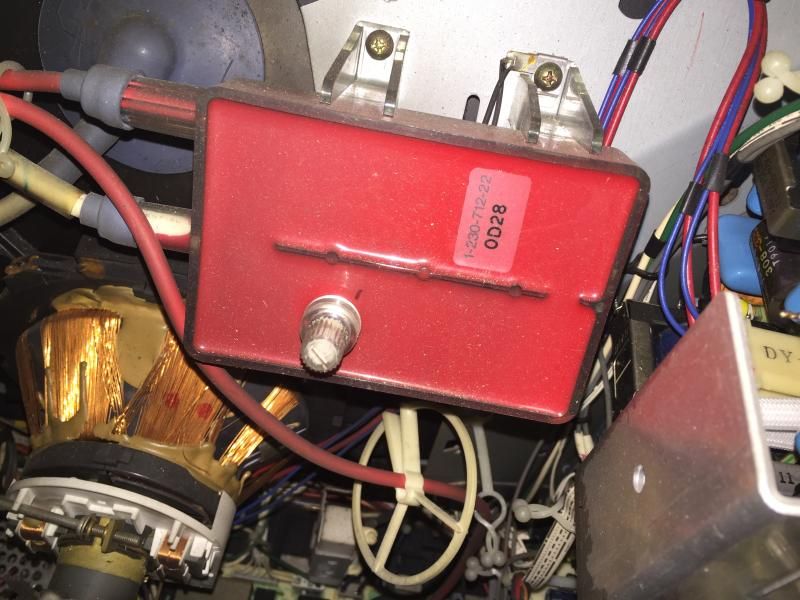
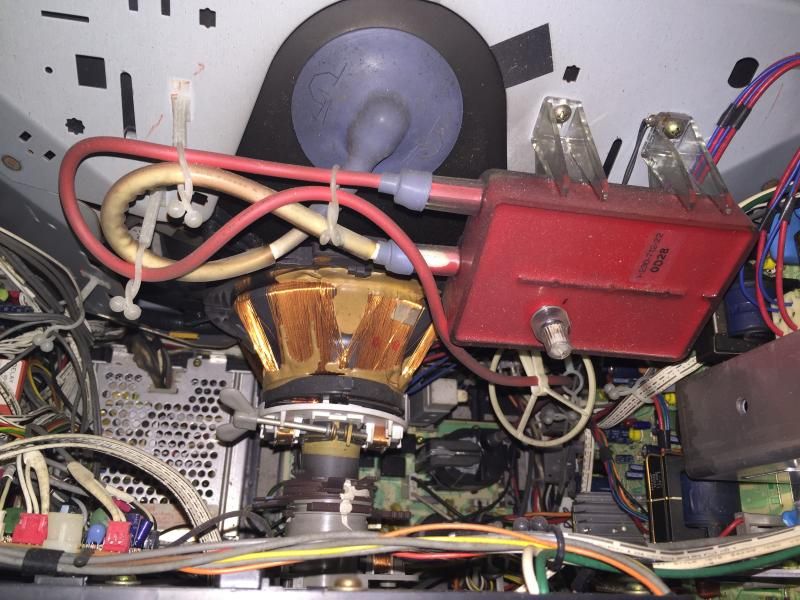
patastinky
Re: PVM-2530 popping sound notice arching/lighting/spark in
.
Last edited by cfx on Thu May 29, 2025 7:38 am, edited 1 time in total.
-
patastinky
- Posts: 24
- Joined: Mon Nov 10, 2014 7:23 pm
Re: PVM-2530 popping sound notice arching/lighting/spark in
Hi!! i'm glad that I was able to help put that to rest for you. I really appreciate you telling me your story. The sound is really scary, at least it was to me at first. In the CL (Craiglist) ad it said that the monitor made a popping sound, but i thought that maybe the speakers might be popped. Not knowing that this monitor don't have built-in speakers. I called the guy up and met with him at his house.cfx wrote:While this won't help you fix yours, I can tell you that this is exactly what happened to my PVM-2530. I bought one new when they were originally sold, and it worked perfectly for a few years. Then it started doing a version of what is discussed in that quoted thread. The picture would blank out and the monitor was essentially off. I would power-cycle it and it would stay on for a few minutes if I was lucky and do it again. I'd repeat this and after maybe an hour of doing that it would stay on. Of course it slowly got worse and then it eventually got where it didn't do it as much. Then one day without it shutting down completely, the picture would jump or wink out and come back, and together with that was that same high voltage popping sound as in your video. I don't know if it was flashing and arcing but I suspect it was. Anyway I knew that sound was the sound of danger so I never used it again. I was clueless about repairing it and knew no one that could fix it so I finally threw it away.
It's kind of cathartic for me to finally know what was wrong with it.
Whatever the "red box" is it is not used in other monitors that I have seen. Normally the wire from the anode cap on the tube goes directly to the flyback transformer. I can't see in your picture, but the other end of the red wire coming from that box should be your flyback.
The guy used to work for a studio and when they decommissioned the PVMs he thought to sell them. They've been sitting in his shed since the early 2k. He turned on the monitor and the popping sound scared the hell out of me. I thought it was going to blow up. In the end i picked up a working PVM-1910q for $10 and he gave me the PVM-2530 for FREE. I was honest with him and told him I would try my best to get it to work. I obviously don't know anything about these monitors, but thanks to forums like this i know that i will learn and perhaps fix the monitor. At the very least i'll get to meet some people along the way and quite possibly help others.
I've edited the photos i took to point out where i believe the FLYBACK to be. It's all the way on at the bottom. I used pink because, hell, why not? lol
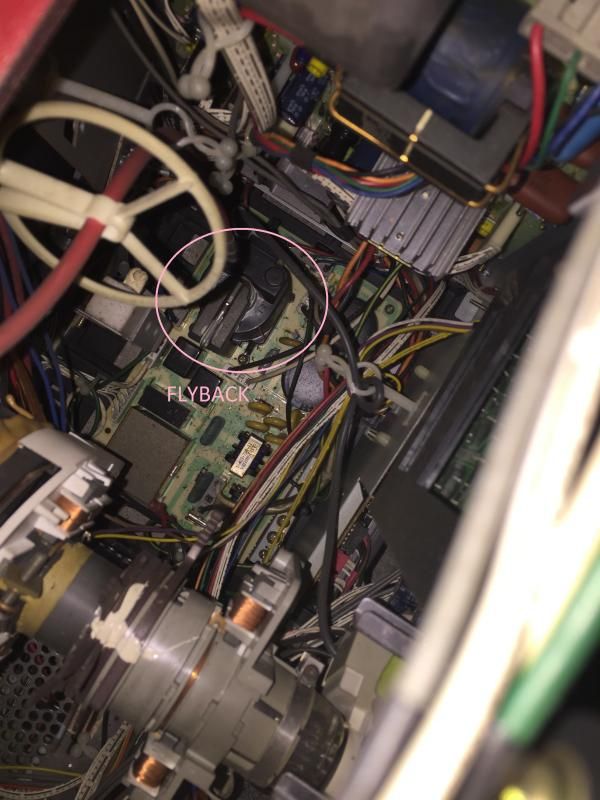
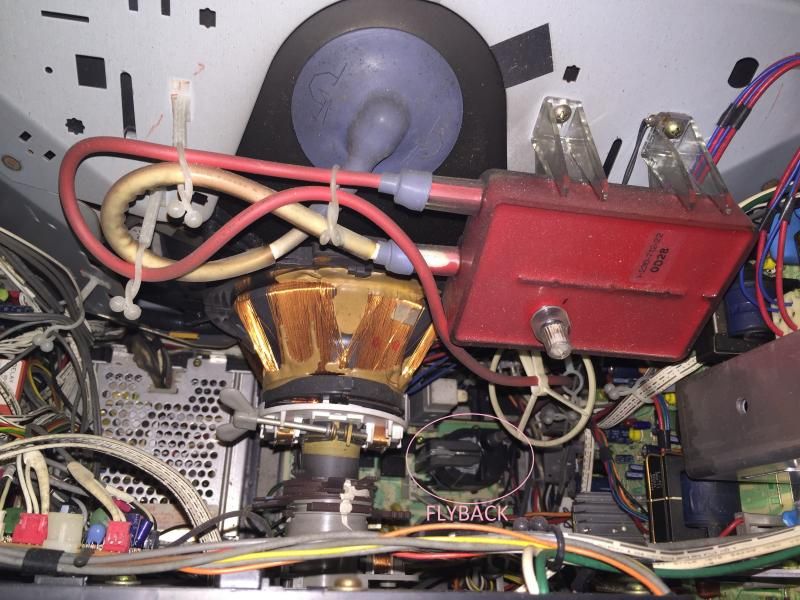
patastinky
Re: PVM-2530 popping sound notice arching/lighting/spark in
Yes, that looks like a regular flyback. You can see that the red wire from the HVR goes to it. Interesting that this model has a HVR in that place. It makes sense that's what it is given that it is being fed the high voltage line. Apparently that's a high-end feature; I haven't seen it in the PVM L2 or L5 series, fairly recent ones at that.
It'd be interesting to open it, if you can do that, to see what's inside and if anything looks serviceable.
It'd be interesting to open it, if you can do that, to see what's inside and if anything looks serviceable.
Re: PVM-2530 popping sound notice arching/lighting/spark in
.
Last edited by cfx on Thu May 29, 2025 7:37 am, edited 1 time in total.
Re: PVM-2530 popping sound notice arching/lighting/spark in
I think you're speaking good sense there sir. Though - up to the point where you junked the parts! You don't have a HVR for pata by any chance?
Re: PVM-2530 popping sound notice arching/lighting/spark in
According to my research, the PVM-2030 and PVM-2530 were the higher end models of that line with 560 TVL (pretty low by mid-90s standards). The lower end models PVM-2130QM and PVM-2730QM with 420 TVL were indeed released as consumer versions in the Profeel line (KX-21HV1 and KX-27HV1, respectively).cfx wrote:I believe that the PVM-2530 and related models are lower-end than the L2 or L5 as far as I know. Retail price on the 2530 was like "only" $1500 and to me these were more like a really high-end consumer Trinitron, while the other PVMs were a bit more like a budget BVM.
-
patastinky
- Posts: 24
- Joined: Mon Nov 10, 2014 7:23 pm
Re: PVM-2530 popping sound notice arching/lighting/spark in
I was thinking of doing just that. Opening up the RED BOX (HVR) and seeing if there is anything i can service inside (bad joint, or blown cap, etc). Will keep you guys posted. Going to try to open her up tonight.. Discharging the CRT would also discharge the HVR, no? It's only been three (3) days since i've NOT turned the TV on.Ed Oscuro wrote:Yes, that looks like a regular flyback. You can see that the red wire from the HVR goes to it. Interesting that this model has a HVR in that place. It makes sense that's what it is given that it is being fed the high voltage line. Apparently that's a high-end feature; I haven't seen it in the PVM L2 or L5 series, fairly recent ones at that.
It'd be interesting to open it, if you can do that, to see what's inside and if anything looks serviceable.
patastinky
-
patastinky
- Posts: 24
- Joined: Mon Nov 10, 2014 7:23 pm
Re: PVM-2530 popping sound notice arching/lighting/spark in
BTW, the part number is 1-230-712-22. I checked with Sonya website repair and its discontinued. The search is now on to find they HVR tonight while I'm away from home (working overtime!)
patastinky
Re: PVM-2530 popping sound notice arching/lighting/spark in
I had some sparking on my screen on one very humid and rainy day and it popped one of the legs off the anode cap out of the tube and was sparking like crazy. I just cleaned the tube and regreased and reseated the cap and it's been fine ever since

Re: PVM-2530 popping sound notice arching/lighting/spark in
Can't be sure without seeing a diagram of it, but it's described as a "resistor assembly" and I doubt there is anything in it to hold a charge. Depends on whether there's a capacitor or not. Seems unlikely to me given that it's dealing with quite high voltages straight from the flyback.patastinky wrote:Discharging the CRT would also discharge the HVR, no?
-
patastinky
- Posts: 24
- Joined: Mon Nov 10, 2014 7:23 pm
Re: PVM-2530 popping sound notice arching/lighting/spark in
What kind of grease did you use?ELabit wrote:I had some sparking on my screen on one very humid and rainy day and it popped one of the legs off the anode cap out of the tube and was sparking like crazy. I just cleaned the tube and regreased and reseated the cap and it's been fine ever since
patastinky
Re: PVM-2530 popping sound notice arching/lighting/spark in
Thinking about that, I realized that it's quite possible the part is fine, it's just not making firm contact (if that's how it is designed, can't quite make sure from the video). For the grease I think that whatever's specified in a recent Sony manual for a similar part should be fine. I'm guessing high dielectric silicone based stuff.
I'd also look to see if the back of the tube is fine - see where the aquadag (black paint stuff) is and if it has any burned spots / holes.
I'd also look to see if the back of the tube is fine - see where the aquadag (black paint stuff) is and if it has any burned spots / holes.
Re: PVM-2530 popping sound notice arching/lighting/spark in
.
Last edited by cfx on Thu May 29, 2025 7:36 am, edited 1 time in total.
-
patastinky
- Posts: 24
- Joined: Mon Nov 10, 2014 7:23 pm
Re: PVM-2530 popping sound notice arching/lighting/spark in
aquadag is the back of the CRT, right? That entire black area? If it is i checked it and no holes or burned spots. Even where it archs, all good.Ed Oscuro wrote:Thinking about that, I realized that it's quite possible the part is fine, it's just not making firm contact (if that's how it is designed, can't quite make sure from the video). For the grease I think that whatever's specified in a recent Sony manual for a similar part should be fine. I'm guessing high dielectric silicone based stuff.
I'd also look to see if the back of the tube is fine - see where the aquadag (black paint stuff) is and if it has any burned spots / holes.
Also i went to discharge the CRT, but didn't hear anything. How can i be sure that it's discharged? Also will this also discharge the HVR?
patastinky
-
patastinky
- Posts: 24
- Joined: Mon Nov 10, 2014 7:23 pm
Re: PVM-2530 popping sound notice arching/lighting/spark in
O.K.
So this morning i received an email from Steve (support@technotronic-dimensions.com). He said that it would appear that the cap is not secure on the CRT. Therefore that might be causing the arching. He also said that there should be some kind of silicon (RTV) inside the cap to secure it so that there are no air pockets. I explained to him that it's fairly easy to spin the cap, he said that is a sign that it's not secured right. I am going to remove the cap and try my best to secure it and see if the TV displays.
As for the part he doesn't have the exact part, but he's looking into a compatible part for me. Stay tuned...
So this morning i received an email from Steve (support@technotronic-dimensions.com). He said that it would appear that the cap is not secure on the CRT. Therefore that might be causing the arching. He also said that there should be some kind of silicon (RTV) inside the cap to secure it so that there are no air pockets. I explained to him that it's fairly easy to spin the cap, he said that is a sign that it's not secured right. I am going to remove the cap and try my best to secure it and see if the TV displays.
As for the part he doesn't have the exact part, but he's looking into a compatible part for me. Stay tuned...
patastinky
Re: PVM-2530 popping sound notice arching/lighting/spark in
LOL high-end feature... more like old-ass feature. Every Sony TV (and of course also monitor) from around 1985-91 has it. And only the bigger 27" and 29" models, that's why you don't find it on 25" and smaller. Just look at this KV-C27 (chassis AE1) from 1988:Ed Oscuro wrote:Interesting that this model has a HVR in that place. It makes sense that's what it is given that it is being fed the high voltage line. Apparently that's a high-end feature; I haven't seen it in the PVM L2 or L5 series, fairly recent ones at that.
http://2.bp.blogspot.com/-L1mwsGHkI1o/T ... G_5033.jpg
and this KV-X2931 (chassis AE1B) from 1992:
http://4.bp.blogspot.com/-EjhU75MRr3E/U ... _05040.JPG
These units are probably interchangeable even if the part numbers aren't the same. Don't try to remove the white lead ending with the suction cup as it's built in. Just disconnect the red lead (there should be a sticker showing how to).
-
patastinky
- Posts: 24
- Joined: Mon Nov 10, 2014 7:23 pm
Re: PVM-2530 popping sound notice arching/lighting/spark in
Hi, MKL,MKL wrote:LOL high-end feature... more like old-ass feature. Every Sony TV (and of course also monitor) from around 1985-91 has it. And only the bigger 27" and 29" models, that's why you don't find it on 25" and smaller. Just look at this KV-C27 (chassis AE1) from 1988:Ed Oscuro wrote:Interesting that this model has a HVR in that place. It makes sense that's what it is given that it is being fed the high voltage line. Apparently that's a high-end feature; I haven't seen it in the PVM L2 or L5 series, fairly recent ones at that.
http://2.bp.blogspot.com/-L1mwsGHkI1o/T ... G_5033.jpg
and this KV-X2931 (chassis AE1B) from 1992:
http://4.bp.blogspot.com/-EjhU75MRr3E/U ... _05040.JPG
These units are probably interchangeable even if the part numbers aren't the same. Don't try to remove the white lead ending with the suction cup as it's built in. Just disconnect the red lead (there should be a sticker showing how to).
http://2.bp.blogspot.com/-L1mwsGHkI1o/T ... G_5033.jpg
The red box is very similar to what i have except that this one is a skinnier and longer. Someone suggested that I make sure the suction cup is secure and that there is little play on it. Currently the suction cup isn't very secure to the CRT. I have pulled the pin back and removed it. They suggested i take RTV silicone and add it to the suction cup so that there is no air in there (or very little). If this doesn't work than i'm going to experiment with different HVRs.
patastinky
-
patastinky
- Posts: 24
- Joined: Mon Nov 10, 2014 7:23 pm
Re: PVM-2530 popping sound notice arching/lighting/spark in
UPDATE: Ok so I unscrewed the HVR and flipped it over. Look what I found. It's without a doubt this piece.
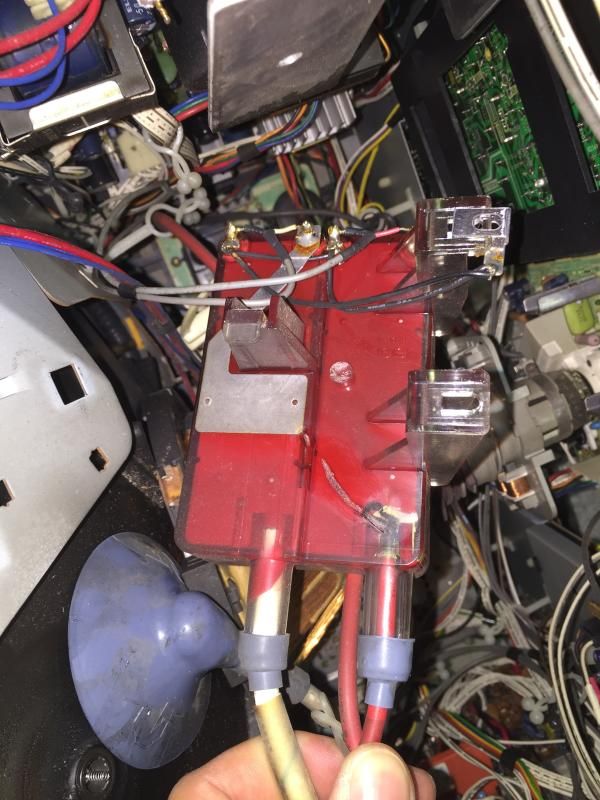
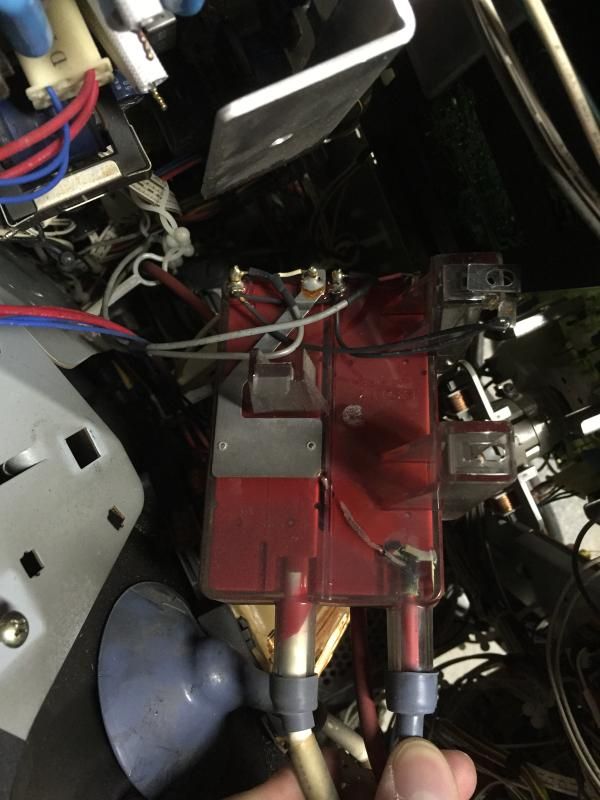


patastinky
-
patastinky
- Posts: 24
- Joined: Mon Nov 10, 2014 7:23 pm
Re: PVM-2530 popping sound notice arching/lighting/spark in
I've hit somewhat of a brick wall here. Someone suggested taking RTV silicone over the crack and see if that works. I'm going to give it a shot tomorrow as that's when the RTV silicone arrives. Other option is to try a different HVR from a different TV. My Part# is 1-230-712-22, but someone suggested i try 1-230-940-11. Not sure what TV that's from, but it's the only shot i have at getting this to work.
Can anyone confirm or recommend a replacement part?
Can anyone confirm or recommend a replacement part?
patastinky
-
patastinky
- Posts: 24
- Joined: Mon Nov 10, 2014 7:23 pm
Re: PVM-2530 popping sound notice arching/lighting/spark in
Update:
O.k. So the RTV Silicone arrived

I put a very large amount over the crack. I made sure to do my best to squeeze it in the crack as well; also tried my best to spread it around as much as i could without comletely covering the bottom of the unit. This is what it looks like now. Looks like i'l have to wait 24hours per instructions before turning her on and seeing if she archs.
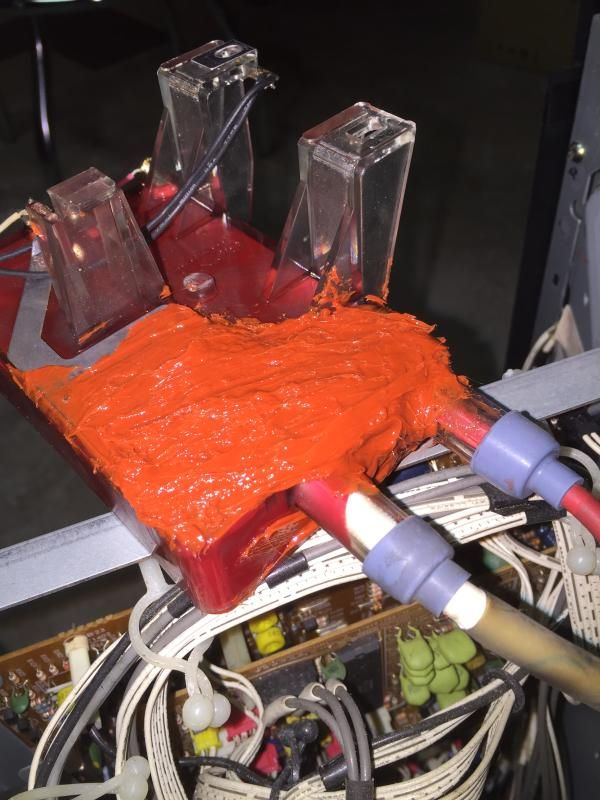
As a precautionary measure I went ahead and pulled the trigger on http://vtvparts.com/obsolete/viewitem.php?productid=618 it's not the exact HVR for my unit, but the shop, as well as members on the board said that it's close enough that it might work. For $16 shipped i'm willing to take the risk. I saved a ton of money going through that guy rather than this guy > $79.99 . http://www.technotronic-dimensions.com/Products3.html
O.k. So the RTV Silicone arrived

I put a very large amount over the crack. I made sure to do my best to squeeze it in the crack as well; also tried my best to spread it around as much as i could without comletely covering the bottom of the unit. This is what it looks like now. Looks like i'l have to wait 24hours per instructions before turning her on and seeing if she archs.

As a precautionary measure I went ahead and pulled the trigger on http://vtvparts.com/obsolete/viewitem.php?productid=618 it's not the exact HVR for my unit, but the shop, as well as members on the board said that it's close enough that it might work. For $16 shipped i'm willing to take the risk. I saved a ton of money going through that guy rather than this guy > $79.99 . http://www.technotronic-dimensions.com/Products3.html
patastinky